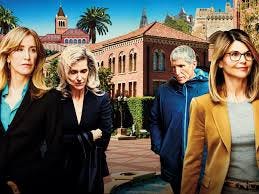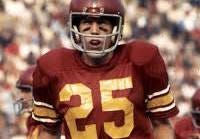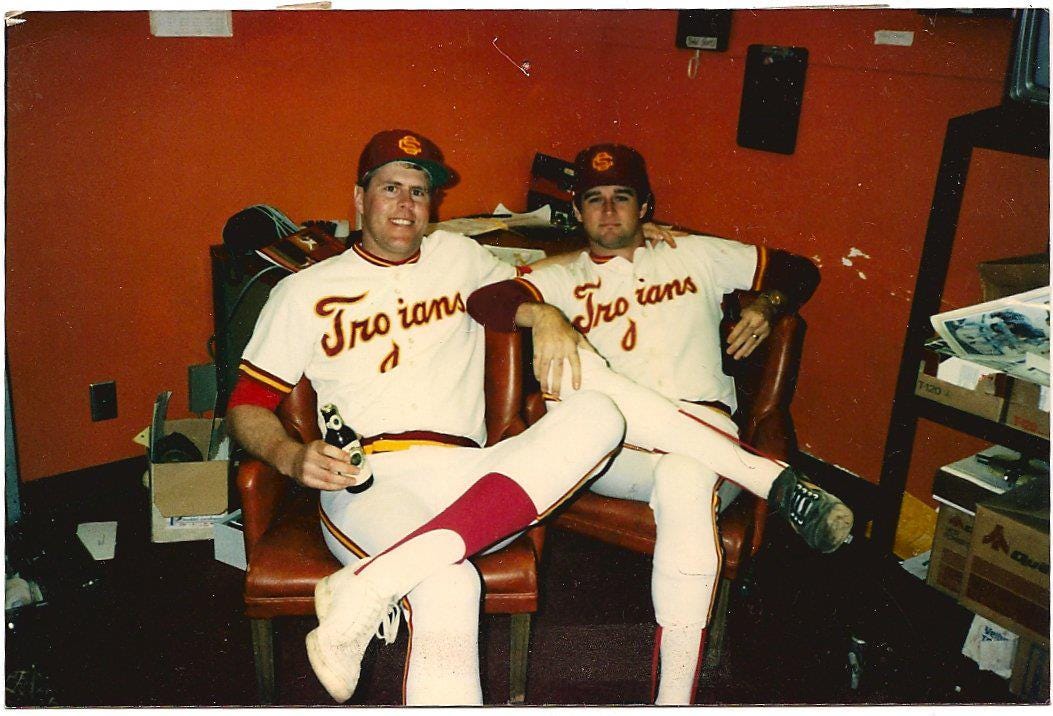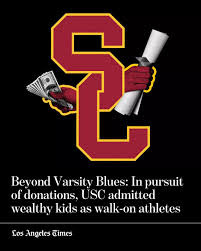I WARNED J.K. MCKAY OF “VARSITY BLUES” 7 YEARS BEFORE IT HAPPENED
The “inside man” at USC could have saved the school embarrassment if listened to
In 2018 the “Varsity Blues” scandal rocked Hollywood, the Ivy League, and USC
In today’s edition (October 26) of the Los Angeles Times, an article informs readers that long before the “Varsity Blues” scandal of 2018 occurred, athletic director Pat Haden and others in the USC athletic administration knew all about the practice.
They did nothing about it.
I knew all of this long before any of it came to light. I warned associate athletic director John K. McKay about it. He did not want to hear about it.
See no evil. Hear no evil. Speak no evil.
The “inside man” at USC
There was a time in which I was the quintessential “inside man” at my alma mater, the University of Southern California. I am not sure exactly how this happened. I was not a member of the administration. I was not with the L.A. Times or any of the big Los Angeles or national media. For a period of this time, I did not even live in Southern California, yet for years whenever anything happened at USC; whenever a rumor or story was floated, other press members called me to find out what really happened.
I suppose that started in 1989, shortly after I graduated from USC. I was not a member of the media yet. It was five years before I would start writing screenplays and call myself a professional writer.
But in 1989-90 I managed the 502 Club, a sports bar located at the corner of Jefferson and McLintock, across the street from campus in the University Village shopping center, all of which has been torn down and is now student housing, parking and school-run businesses.
But in 1989 it was the hottest sports bar in L.A. It was owned by my friend Anthony “Bruno” Caravalho. On Thursday nights there was a line out the door. On Saturday nights after football games at the Coliseum, it was jam-packed. I met O.J. and Nicole Simpson and Marcus Allen in there. In those days it was full on Sundays after Los Angeles Raiders games. If there was any NFL rule against pro cheerleaders fraternizing with NFL players, that rule was not followed at the “Five-Oh,” where you can use your imagination when it came to what these players were doing with these gorgeous girls. Actors and celebrities all came through the doors.
But mainly the place was the hang out of Trojan athletes, in particular a group of football players led by quarterback Todd Marinovich. I knew all these guys very well. Without getting into too much detail, let me just say that in the “Five-Oh” there were drugs, sex, gambling, and illicit activity. Coach Larry Smith banned his players from the “Five-Oh” but nobody paid any attention to him. The daughter of a head athletics coach at the school took on a large group of athletes in a sex fest, as did a Playboy model and a porn star at a bachelor party.
It was “anything goes.” It was like the rumors about Clara Bow, famed silent “flapper,” who was a big “fan” of the Trojans in the 1920s.
Much of this was revealed because Marinovich’s troubles became public when he signed with the Raiders, by which time the wildest parties were no longer at the “Five-Oh” but his Manhattan Beach pad, sight of much more debauchury and bacchanalia.
But not all of it, including a big construction magnate with a gambling addiction and a Trojan player who mysteriously played very poorly in a very big game against a major rival.
By 1995, I was a screenwriter, a “professional” in that Frank Capra, Jr. had optioned one of my scripts. That was when Bruno, who no longer owned the “Five-Oh,” approached me about writing a book about all the scandalous stuff that happened at his old bar.
I approached Don Yeager, who had just written Under the Tarnished Dome, a tale of under-the-table payments during the Lou Holtz era at Notre Dame. But Yaeger eventually said, “Nobody cares about USC anymore.” The program was second-tier at the time and thank God I never wrote that story.
A decade later, when I was writing best-selling books about USC during the Pete Carroll era, I might have been persona non grata at the school had I revealed what I knew about USC back in 1989.
However, some years later, I saw a troubling pattern revealing itself. Those players I knew so well in 1989 were star-crossed. Something very dark was happening but nobody quite realized what. Players I interviewed for my 2009 book What It Means to Be a Trojan began reaching out to me, telling me they suffered from concussions and could I help them?
I went to J.K. McKay asking if he could do anything. Could USC create a fund to help these stricken athletes?
As with the “Varsity Blues” story I was met with a stone wall. Apparently the feeling was that if they paid these players it would constitute liability and open them up to lawsuits, as if this eventuality can be stopped anyway.
I approached my friend Mark Fainaru-Wada (Game of Shadows). No interest. I approached ESPN. No interest. I approached my publishing contacts. No interest.
Then came all the revelations about concussions.
Something like five linebackers from the 1989 team died, ostensibly from concussion-related injuries, prior to age 50 or 55. This included Junior Seau, who was not the only one who committed suicide. At least one other player did, and another practically did through reckless actions.
Finally in 2020 Sports Illustrated stole my story and printed it.
Typical.
Between 2006 and 2009 I published some five books about Trojan football. They sold like hot cakes. I had lines out the door at the USC Bookstore or when I made appearances outside the peristyle section of the Coliseum.
Because of this, people began contacting me to get to the bottom of the latest Trojan news. I knew the right people, at the school, in the football program, and in the media. At one point SID Tim Tessalone asked me to be discreet about what I revealed about inside doings at USC.
In 2011, I was contacted by Bruce Macgowan, the producer of Chronicle Live, a popular show on the Bay Area Sports Network hosted by my friend Greg Papa. Could I confirm that Pete Carroll was leaving USC, and would I be able to air that confirmation on their show that evening?
I made several calls, including to Garry Paskwietz, who hosted a popular USC recruiting web site, and also Harvey Hyde, who had interviewed me numerous times on his “Trojan Talk” radio show.
Both confirmed that the rumors were true. I went on the air that night and broke the news.
John K. McKay blew off the story and USC paid for it
McKay
In 2007 I had published One Night, Two Teams: Alabama vs. USC and the Game That Changed a Nation. I interviewed some 80 USC and Alabama players, coaches, media and professors, including John K. McKay, a USC star and son of coach John McKay. We became friends. I did a follow-up interview with him with my daughter at my side at the prestigious Jonathan Club in Santa Monica.
Travers and Terry Marks, former graduate assistant coaches. Had Marks, former president of Coca-Cola/North America been named Pac-12 Commissioner or USC athletic director, there would be no Varsity Blues and the Pac-12 would still be thriving.
After the Reggie Bush investigation ended up with USC going on probation, athletic director Mike Garrett was forced out. That was another story I broke. J.K. told me he was going to be named Garrett’s successor, which I also revealed. I told him I would like to be a part of his administration at Heritage Hall. In particular, the Pac-12 Network was coming into being and I wanted to be in charge of producing USC sports stories, much like what we see with SEC Storied. In fact my good friend Terry Marks was a finalist for Pac-12 Commissioner, which was given to some clown named Scott. If Terry had gotten the job, the Pac-12 Network would have been better than the SEC Network and the conference would still exist, probably with a recent national champion or two.
J.K. told me I was in. “I’ll bring you along,” he said.
It turned out J.K. was not named athletic director. His best friend Pat Haden was. J.K. was made associate athletic director, but when it came time to hire me as promised, I was left out in the cold.
Recruited walk-ons
It was during this time that I was told by a man I trust, an ex-Major League baseball player who around 2011 was a scout and would be a major supplier of American talent to the Japanese pro leagues, that a particular coach at USC was taking bribes from wealthy parents who wanted to get their kids into the school. The children were identified as high school athletes, not good enough to be offered scholarships, but good enough to play as “recruited walk-ons” at USC.
This meant that if the player in question did not have the grades to matriculate into USC he could get in on the coaches’ recommendation. Some of these walk-ons were not good enough to even be recruited walk-ons. Recruited walk-ons usually are high school or junior college stars, as I had been when USC assistant baseball coach Marcel Lachemann made me a recruited walk-on coming out of Santa Monica College back in the day.
But the coach in question was taking bribes from these parents. I knew that if this became public it would be a huge scandal. I called McKay and told him I had no desire to “rat out” anybody but that if he did not “nip this thing in the bud,” it was going to “come back and bite the school in the ass.”
McKay did not want to hear about. As best I figured, he hoped it would go away on its own. He buried it.
The coach in question was fired, but as far I could tell it was because he was not a good coach and his team lost. Obviously nobody did anything to stop the endemic practice of bribing coaches to get recruited walk-ons into school. In 2018 Variety Blues proved that.
The scandal Travers warned McKay about was dismissed but keeps haunting USC
Now the L.A. Times reveals what I knew all along, that Haden and McKay knew about it 13 years ago.
I held on to this knowledge a long time until recently another scout told me he knew all about the coach in question accepting bribes and that it was common knowledge, which is why I am revealing it now, the day of the Los Angeles Times revelations.
Pride goeth before the fall.
Steven Travers is a former screenwriter who has authored over 30 books including The Last Icon: Tom Seaver and His Times. He is a USC graduate and attorney with a Ph.D who taught at USC and attended the UCLA Writers’ Program. He played professional baseball, served in the Army JAG corps in D.C., was in investment banking on Wall Street, worked in politics, lived in Europe, and was a sports agent before finding his calling as a writer. He has written for the San Francisco Examiner, L.A. Times, StreetZebra, Gentry magazine, Newsmax, Substack and MichaelSavage.com. He lives in California and has one daughter, Elizabeth. He can be reached at USCSTEVE1@aol.com or on Twitter @STWRITES.







